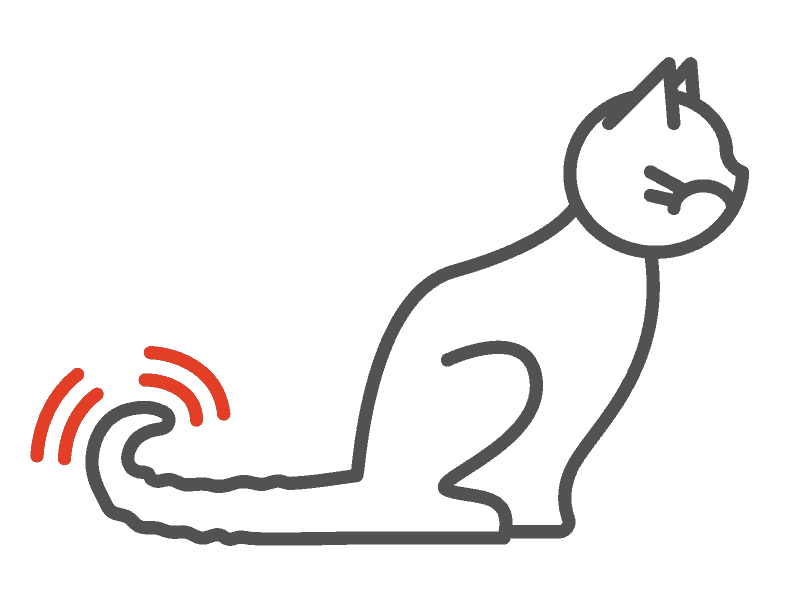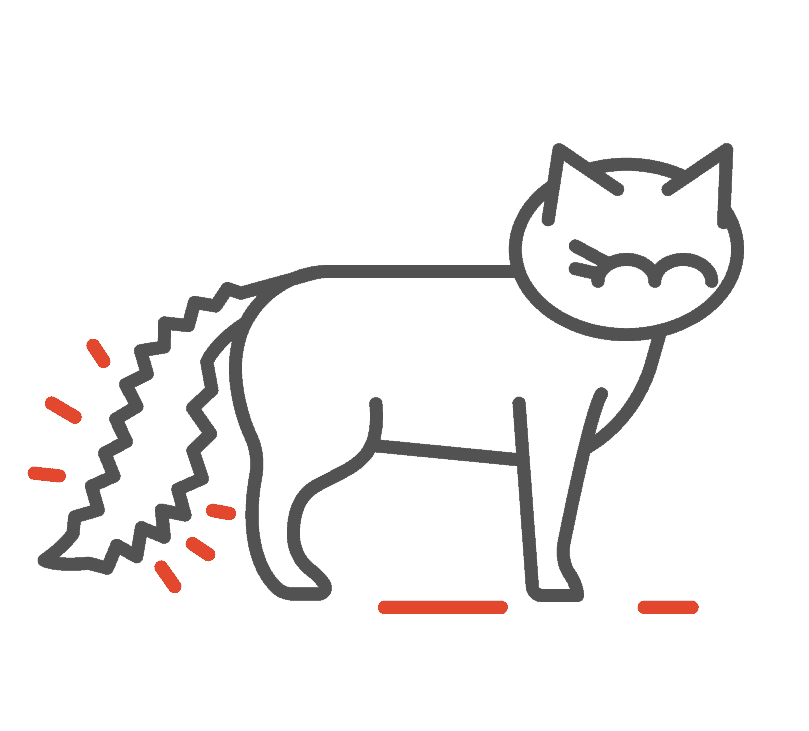Cat body language is a lot more subtle than the body language of humans, or even dogs. A lot of people struggle with understanding cats’ emotions, but with a bit of research, you’ll find that cats are a lot easier to read once you understand their body language. (Related: Can Cats Understand Words?)
One surprising way cats can communicate their emotions is through their tails. Read on to find out how you can become an expert at understanding your cat.
The Basics of Cat Body Language
One of the most important things to understand about cat body language is that one movement can have a lot of different interpretations based on context. For example, when a cat flattens its ears, this typically indicates anger or fear. In other contexts, though, your cat could simply be listening to a sound behind it.
In order to truly become an expert at reading your cat’s body language, you have to learn how to read your cat’s body language as a whole. Never look at just one part of your cat’s body to indicate its mood; your cat will use its whole body to communicate how it’s feeling!
What Your Cat’s Tail Is Trying to Tell You
Cats can say a lot with their tails, but to the untrained eye, their tail movements can appear quite random and confusing. Here’s a helpful guide so you can know what your cat is trying to communicate with its tail!
Tail Straight Up
A cat that is walking or standing with its tail straight up is feeling friendly, happy, and confident. Cats with their tails sticking straight up are usually in a friendly mood, as well. Stick your hand out for your cat to sniff, and it might just come up to you for some cuddles and affection.

Tail Straight Up and Curled at the Top
If your cat stands with its tail straight up but curled at the top like a question mark, it means your cat is happy to see you! This is a common way that cats greet their owners, especially if you’ve just arrived after running errands or a long day at work.
This tail position can also simply mean your cat is feeling friendly. Cats with this tail position are usually in the mood to interact with their owners, and this is a great time to pet your cat or play with it.

Tail Lashing from Side to Side
If your cat is quickly lashing its tail from side to side, it usually indicates extreme anger or fear. If you’ve been disrespecting your cat’s boundaries, or if it feels threatened by you or something else nearby, your cat will likely flatten its ears and lash its tail. It might also growl, hiss, or even lash out with its claws or teeth.
However, in other situations, cats might whip their tails back and forth when they are extremely playful, or are feeling challenged. This is especially common in playful kittens who are very excited by a new toy or sensation.

So, while a lashing tail is often a sign of anger or fear, it can also mean your cat is focused and playful. If you are unsure about what your cat’s lashing tail indicates, keep an eye on the position of its ears, as well as what your cat is doing. An angry or fearful cat will not be engaging in play behavior, and a playful cat will not be hissing or lashing out.
Tail Twitching Quickly
A quickly twitching tail is often an indication that your cat is irritated. If you’re petting your cat and its tail begins to twitch more and more quickly, it’s usually a sign that your cat is becoming frustrated, and would like to be left alone.

In many cases, a quickly twitching tail is a cat’s way of warning you that it will become aggressive if you continue to push its boundaries. Cats rarely lash out without warning; flattened ears, growling, and a twitching tail are all potential precursors to a cat attacking you. Keep a close eye on your cat’s body language so you can back away and give it personal space if it’s feeling annoyed.
Sometimes, a quickly twitching tail can actually indicate that your cat is playful and focused, so keep an eye on the rest of your cat’s body language. Are its ears flattened, or is it growling? If so, it’s most likely your cat is upset.
Tail Twitching Slowly
If your cat’s tail is twitching more slowly, it is usually an indicator that you cat is focused. This behavior is most commonly seen in cats that are playing or about to pounce on something (or someone).
Sometimes, however, a slowly twitching tail is also an indicator of annoyance or frustration, so be careful to pay attention to your cat’s overall body language.

Tail Puffed Up
When a cat’s tail is puffed up, it usually means it’s afraid, especially if the tail is accompanied by other signs of unease like flattened ears and a tense body. If your cat is sitting down with its tail puffed, it means it’s been spooked and is feeling uneasy.

If your cat is standing up with its back arched and its tail puffed, however, that means it’s especially terrified.
A puffed out tail doesn’t always mean the cat is afraid. A slightly puffed out tail can be a sign of affection by a cat towards another cat.
Tail Straight Down
If your cat’s tail is held straight down, it means it’s feeling aggressive or fearful. If you notice your cat’s tail is straight down, its ears are flattened, and it’s moving slowly and deliberately, then it’s best to leave your cat alone now!
Keep in mind, however, that some cat breeds, like Persians, naturally hold their tails low in a neutral position.

Tail Tucked Between Legs
Finally, if your cat tucks its tail between its legs, it is likely feeling submissive, fearful, or uneasy. This is a good time to give your cat some personal space.
If you think your cat is nervous due to loud noises or other external stimuli, try and keep your cat’s environment quiet and non-threatening so it can calm down and feel more secure.
4 reasons why cats wag their tails
Conclusion
Cats can say a lot with their tails, but it can take some time to become good at reading your cat’s body language. While your cat’s tail can tell you a lot about its mood, keep an eye out for other forms of body language, like ear position and vocalization.
With time and research, you can become an expert at understanding your cat’s emotions through their tails.
Read next: Cats Prefer Baby Talk
Related
- Do Cats Understand Pointing?
- Ways That Cats Communicate With Each Other
- Ways That Your Cat Expresses Happiness
- Why Don’t Some Cats Like to be Held?
- Why Do Some Cats Bite When You Pet Them?
- How Cats Communicate Through Purring
- Can Cats Understand Words?
- What are Cat Pheromones, and Do They Work to Calm Cats?
- Zoosemiotics of Cats
- Why Do Cats Knead?








